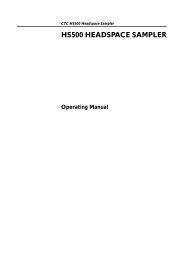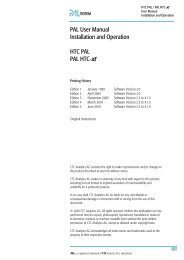Addendum to PAL User Manual Installation and ... - PAL System
Addendum to PAL User Manual Installation and ... - PAL System
Addendum to PAL User Manual Installation and ... - PAL System
You also want an ePaper? Increase the reach of your titles
YUMPU automatically turns print PDFs into web optimized ePapers that Google loves.
2.1. GC-Injec<strong>to</strong>r Type or Mode<br />
<strong>Addendum</strong> <strong>to</strong> <strong>PAL</strong> <strong>System</strong> <strong>User</strong> <strong>Manual</strong><br />
<strong>PAL</strong> ITEX-2 Option<br />
The recommended GC instrumentation is a split injec<strong>to</strong>r with a split liner<br />
<strong>to</strong> provide enough volume <strong>to</strong> receive the gas phase from the ITEX thermal<br />
desorption step. Whether the split is closed or open depends greatly on<br />
the particular application <strong>and</strong> must be defined case by case.<br />
2.2. GC-Injec<strong>to</strong>r Septum<br />
The st<strong>and</strong>ard injec<strong>to</strong>r septum can be used; however, ITEX needle gauge 23<br />
is appropriate for the Merlin adapter.<br />
If a Merlin adapter is used, be aware that the seal can leak if used with a cold<br />
injec<strong>to</strong>r (cold injec<strong>to</strong>r <strong>to</strong> start with, ramping the temperature up at the start of<br />
injection; see text below).<br />
2.3. GC-Injec<strong>to</strong>r Temperature<br />
As a st<strong>and</strong>ard starting condition, injection in<strong>to</strong> a hot injec<strong>to</strong>r is recommended,<br />
typically 200 °C isothermal. Check the peak shape <strong>and</strong> reproducibility <strong>and</strong><br />
vary the parameters if necessary <strong>to</strong> improve the results.<br />
For extremely volatile compounds, such as vinyl chloride or 1,2-dichlorethane,<br />
different experiments have been done, such as starting with a cool injec<strong>to</strong>r<br />
<strong>and</strong> ramping the temperature up quickly. Another approach has been <strong>to</strong><br />
cryofocus the sample before the actual transfer <strong>to</strong> the GC column.<br />
This provides some ideas on how <strong>to</strong> adapt if problems arise with a specific<br />
application. The final method selected depends mainly on the available GC<br />
equipment <strong>and</strong> application.<br />
2.4. GC-Injec<strong>to</strong>r EFC/EPC<br />
One important point <strong>to</strong> be aware of is the combination of high column<br />
backpressure <strong>and</strong> electronic flow or pressure carrier gas control. If column<br />
backpressure is relatively high, for example 2 bars (or approx. 25 <strong>to</strong> 30 psi)<br />
<strong>and</strong> a gas plug from the ITEX-2 device is brought in<strong>to</strong> the injec<strong>to</strong>r, the injec<strong>to</strong>r<br />
pressure will rise <strong>and</strong> will possibly reach the EFC/EPC limit <strong>to</strong> control the<br />
flow/pressure efficiently <strong>and</strong> accurately. Reaching a critical pressure limit for<br />
the electronic control causes the GC control <strong>to</strong> open the split until the<br />
pressure returns <strong>to</strong> a normal level. This opening of the split is not very<br />
obvious <strong>to</strong> the user; the peak shape is still good but reproducibility can be<br />
very bad, relative st<strong>and</strong>ard deviations of 20 <strong>to</strong> 40 % have been observed.<br />
For the user it is easy <strong>to</strong> moni<strong>to</strong>r the split flow. Connect a flow meter <strong>to</strong> the<br />
split-outlet line <strong>and</strong> moni<strong>to</strong>r the split flow during the injection process.<br />
Such high backpressures may be due, for example, <strong>to</strong> a capillary column<br />
of 0.25 mm I.D. <strong>and</strong> length of 60 <strong>to</strong> 80 meters.<br />
39




